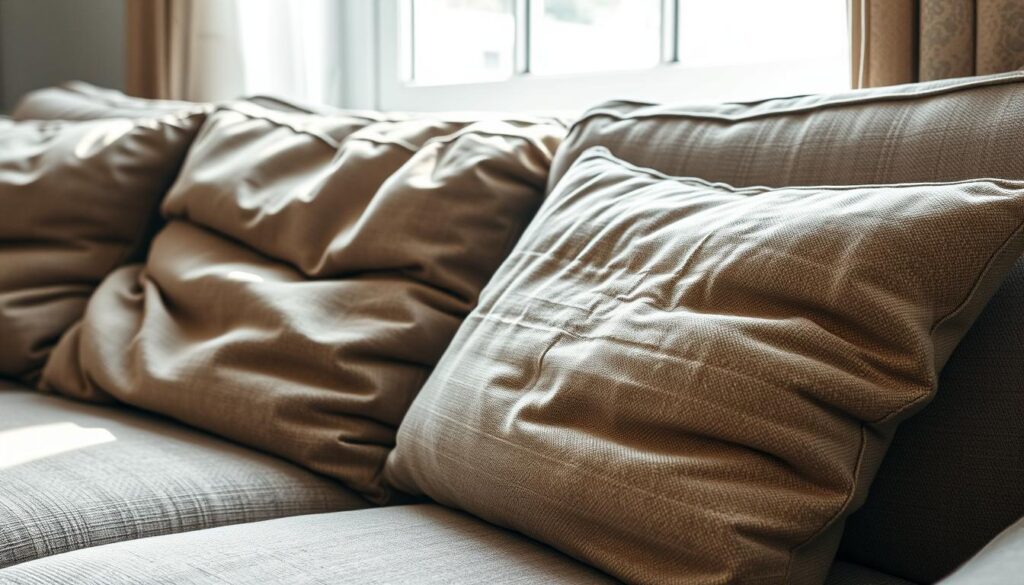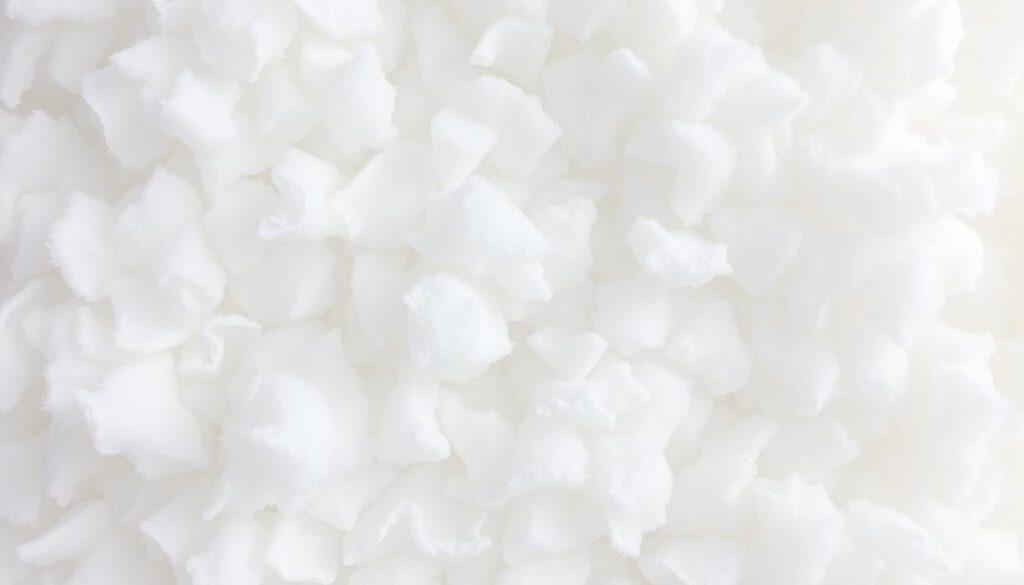Are you tired of sinking into your couch cushions only to find they’re no longer providing the comfort they once did? If so, you’re not alone. Many people find their sofa has become uncomfortable and unsightly just months after purchasing it.
The average sofa is said to last approximately seven years, but this can vary significantly depending on the quality of your cushions. If your couch is sagging, it doesn’t mean it’s destined for the skip. Chances are, it’s just the cushions that need upgrading or refilling, perhaps with new foam.
Key Takeaways
- Discover comprehensive solutions to restore your sagging couch cushions to their former glory.
- Learn to identify the causes of cushion sagging and apply practical fixes.
- Understand the construction of your sofa cushions to select the most effective repair method.
- Explore DIY fixes and refilling methods for long-lasting results.
- Extend the life of your sofa with proper maintenance and techniques.
Why Sofa Cushions Sag and When to Take Action
Over time, your sofa cushions may start to lose their shape, leading to an uncomfortable sitting experience. This issue is not just about aesthetics; sagging cushions can affect the overall usability of your couch.
Common Causes of Sagging Cushions
Several factors contribute to sagging couch cushions. Daily use and constant pressure on cushions lead to compression of the filling materials, causing them to lose their shape and resilience. Low-quality foam cushions are particularly prone to this issue. Additionally, sitting in the same spot repeatedly can create uneven wear, accelerating sagging in specific areas.

Signs Your Cushions Need Attention
It’s essential to identify when your cushions need attention. Look out for visible indentations that don’t bounce back, a noticeable tilt when sitting, uncomfortable pressure points, and cushions that look flat and lifeless. If you find your sofa has become uncomfortable or the sitting spot has become a depression, it’s time to take action.
Assessing Your Sofa Cushion Type
Assessing the type of sofa cushions you have is vital for choosing the right restoration approach. To determine the filling material, you should inspect your cushions closely.
Start by removing the cushion covers and checking the filling. If you find a fibrous material, it’s likely that your cushions are fibre-filled. Feathers and down are also common fillings, offering a luxurious feel but requiring regular maintenance.
Foam-Filled Cushions
Foam-filled cushions are the most common type and provide structured support. However, they can compress over time, especially if made from low-density foam. High-density foam is recommended for seat cushions, particularly for those 1″-4″ thick.
Feather and Down Cushions
Feather and down cushions offer a soft, sink-in feel but need regular fluffing to prevent clumping. Some premium cushions feature a hybrid construction with a foam core wrapped in feathers or down.
Fibre-Filled Cushions
Fibre-filled cushions, often made from polyester, offer a middle ground between foam and feathers. However, they can mat down and lose volume more quickly.
| Cushion Type | Filling Material | Recommended Use |
|---|---|---|
| Foam-Filled | High-density foam | Seat Cushions |
| Feather and Down | Feathers or down with foam core | Back Cushions or luxurious seating |
| Fibre-Filled | Polyester fibre | General seating, softer feel |
Quick Fixes for Sagging Sofa Cushions
Sagging sofa cushions can be a nuisance, but there are several quick fixes you can try to restore your sofa’s comfort. Regular maintenance is key to extending the life of your couch cushions. By implementing a few simple techniques, you can prevent sagging and keep your sofa looking its best.
Rotate and Flip Regularly
One of the simplest ways to prevent sagging is to rotate and flip your cushions regularly. This helps distribute the wear evenly across the cushions, preventing permanent depressions from forming. For heavily used sofas, it’s recommended to rotate the cushions every 1-2 weeks, while less frequently used furniture can be maintained on a monthly basis.
Beat and Fluff Technique
The beating and fluffing technique is particularly effective for feather, down, and fibre-filled cushions. By removing the cushions from the sofa and gently beating them, you can loosen compacted filling and redistribute it evenly. This helps restore the cushions’ original shape and loft.
Temporary Support Solutions
For severely sagging cushions, temporary support solutions like sofa savers or cushion support boards can provide immediate improvement. These can be placed beneath the cushions to add extra support and firmness. You can also repurpose firm foam sheets or plywood cut to size for a DIY fix.
How to Fix Sagging Sofa Cushions with Replacement Filling
A sagging sofa can be revitalised by focusing on the cushion filling. Over time, the filling in your sofa cushions can lose its shape and support, leading to a sagging appearance. Fortunately, replacing the filling can restore your sofa’s comfort and aesthetic appeal.
Replacing Foam Inserts
Replacing foam inserts is a highly effective method for reviving sagging sofa cushions. To start, you’ll need to remove the existing foam insert core and replace it with a new one, preferably made from high-density foam. High-density foam is durable and can withstand regular use, making it an ideal choice for sofa cushions.
When selecting replacement foam, opt for high-density foam (typically 1.8-2.5 pounds per cubic foot) to ensure durability and resistance to compression. Measure your existing cushion covers carefully before ordering replacement foam, allowing about 1 inch extra in all dimensions for a snug fit.
Adding Batting or Fiberfill
In addition to replacing foam inserts, you can enhance the comfort and appearance of your sofa cushions by adding batting or fiberfill. Batting is a soft, fluffy material that can be made from polyester or cotton, available in sheets or rolls. It adds volume and helps restore the plumpness of your cushions.
For a more economical solution, consider using polyester fiberfill, which is effective for fibre-filled cushions that have lost volume. Adding batting around foam inserts not only creates a softer appearance but also protects the foam from friction against the fabric cover.

Re-stuffing Feather Cushions
For feather and down sofa fillings, consider re-stuffing the cushions or adding additional filling such as foam. Creating a “feather envelope” design with a foam core wrapped in feathers or down can provide the perfect balance of support and luxurious softness.
When working with feather fillings, use a vacuum sealer or compression technique to temporarily reduce volume while inserting into cushion covers, making it easier to close zippers.
Generate an image of down feather filling for sofa cushions
For a step-by-step guide on refilling your sofa cushions, including measuring for new foam or filling, removing old filling safely, and installing new filling materials, visit our detailed article on fixing sagging sofas.
Step-by-Step Guide to Refilling Sofa Cushions
Breathing new life into your sagging sofa cushions starts with understanding the refilling process. Refilling your couch cushions can significantly enhance the comfort and appearance of your sofa. This guide will walk you through the necessary steps to achieve this.

Measuring for New Foam or Filling
To begin, you need to measure the interior dimensions of your cushion covers when they are empty. It’s crucial to account for seam allowances and the desired firmness of your cushions. For foam replacements, measure the length, width, and depth, and then add approximately 1 inch to each dimension to ensure a plump appearance after insertion.
Removing Old Filling Safely
When removing the old filling, it’s advisable to work in a well-ventilated area and consider wearing a dust mask, as older materials may release dust and particles. You can salvage any portions of the original filling that remain in good condition to combine with new materials, particularly for feather or down cushions.
Installing New Filling Materials
For foam inserts, you may need to fold or roll them temporarily to fit through the cushion opening, allowing them to expand inside the cover. When using batting, wrap the foam core evenly on all sides before insertion. For loose fillings like fiberfill or feathers, add material gradually, checking the fullness and firmness until you achieve the desired result.
After refilling, allow your cushions to settle for 24-48 hours before heavy use. This allows materials like foam to fully expand and conform to the cover shape, providing optimal support and comfort for your sofa or couch.
Conclusion: Maintaining Your Refreshed Sofa Cushions
To keep your sofa in top condition, maintaining your refreshed cushions is crucial. Regular maintenance is key to preserving your newly refreshed couch cushions. This includes rotating them every two weeks and performing a thorough fluffing and beating session monthly.
Using high-quality, natural materials for your couch can also extend their lifespan. Additionally, protecting your investment with arm covers and throws, and considering scotchguarding fabric, can prevent stains and premature wear. If you notice your sagging couch issue persists, it may be due to the base springs, and you may need to consider restringing or using a hard seat saver pad.
By following these tips, you can enjoy a comfortable, supportive sofa for many years, saving money and reducing furniture waste.



